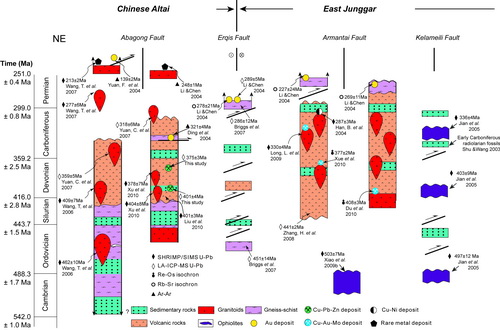Contrasting styles of mineralization in the Chinese Altai and East JunggarUpdate time:12 27, 2011
Postdoctor WAN Bo and his teacher XIAO Wenjiao review the metallogenic framework and development of the Chinese Altai and East Junggar so as to decipher and better understand the tectonic processes that have contributed to the evolutionary growth of this accretionary orogen. The time and space distributions of diverse and diagnostic ore deposits across the Altai–East Junggar collage strongly indicate that two independent Palaeozoic island arcs developed from different subduction zones. The Chinese Altai arc, a Japanesetype arc, hosts many VMS deposits, whereas the East Junggar arc, a Mariana-type arc, contains porphyry Cu–Au–Mo deposits. These relationships support the concept that the Altaids are a multiple subduction–accretion collage. VMS deposits and porphyry deposits formed during the building of the Chinese Altai and East Junggar arcs, respectively. Subsequently, the two arcs were juxtaposed and the Chinese Altai arc was thrust southwards over the East Junggar arc along Erqis Fault. During the transition stage from contraction to extension between these two arcs, decreasing pressure and increasing temperature triggered largescale hydrothermal fluid activities that have leached gold from wallrocks. The Erqis Fault acted as a fluid channel and location for lode gold deposits.
Fig. 1. Space–time diagram demonstrating the spatial and tectonic relationships between the tectonostratigraphic units of the Altai. (Image by WAN)
Fig. 2. Schematic time-diagrams illustrating the tectonic and metallogenic evolution of the Altai–East Junggar collage. (Image by WAN) Wan et al. Contrasting styles of mineralization in the Chinese Altai and East Junggar, NW China: implications for the accretionary history of the southern Altaids. Journal of the Geological Society. 2011, 168(6): 1311-1321 (Download Here)
|
Contact
Related Articles
Reference
|
-
SIMSSecondary Ion Mass Spectrometer Laboratory
-
MC-ICPMSMultiple-collector ICPMS Laboratory
-
EM & TEMElectron Microprobe and Transmission Electron Microscope Laboratory
-
SISolid Isotope Laboratory
-
StIStable Isotope Laboratory
-
RMPARock-Mineral Preparation and Analysis
-
AAH40Ar/39Ar & (U-Th)/He Laboratory
-
EMLElectron Microscopy Laboratory
-
USCLUranium Series Chronology Laboratory
-
SASeismic Array Laboratory
-
SEELaboratory of Space Environment Exploration Laboratory
-
PGPaleomagnetism and Geochronology Laboratory
-
BioMNSFrance-China Bio-mineralization and Nano-structure Laboratory

 Print
Print Close
Close

